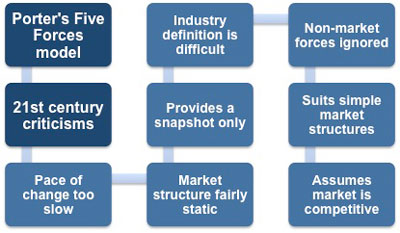Advantages and Disadvantages

Whilst the Porter's Five Forces model has its benefits there are certain considerations you should bear in mind when using it. Many of these come from the fact that it was developed in an environment that was quite different to the one organizations find themselves operating in today.
 |
These considerations are:
• Pace of change is now more rapid.
• Market structures were seen as relatively static.
• The model provides you with only a snapshot of your environment.
• It can be difficult to define the industry
• The model does not consider non-market forces
• The model is most applicable for analysis of simple market structures
• The model is based on the idea of competition.
Today's market is considerably altered from that of the late 1970s, especially in terms of the rate of change industries experience and the stability of market structures. Changes in technology occur regularly and their impact is virtually instant and can cause significant disruption to a market.
Very few market structures have remained static, and new entrants, the availability of venture capital, barriers to entry, and supply chain relationships can change to such a degree that an organization's business model needs to change radically to retain its market position. Technological changes have also significantly reduced the length of time a product has between its conception and its market maturity.
Without regular updates, any knowledge gained from using Porter's model will quickly be out of date as it was only designed to provide a snapshot of any particular market. The model is not able to provide you with meaningful information about how best to take preventive actions. It does, however, offer suggestions as to where the challenges and threats to your organization are most likely to occur through its examination of substitutes.
Sometimes the dynamics of industries and corporations can make it difficult to define the market or industry. For example,
Is Walmart in the general retailing market, or should they consider each major product line separately, and if so to what degree? Should they class all electrical goods together, split them into white goods and electronic goods, or split them at some lower level (audio, video, computers, small kitchen appliances, white goods, etc.)?
The wide variety of product lines that many modern organizations carry create their own difficulties when defining markets and this may need to be done at a product level to be meaningful.
Porter's model also has difficulty in integrating the complexities of today's markets with the frequent inter-relations and product groups of organizations. If your organization defines its market segment too narrowly to fit into the model there is a risk that key elements may be overlooked, for example legislation and the interactions between sellers and buyers.
Organizations have to respond to more than just market forces. They need to be aware of, understand the implications of, and respond to government legislation, corporate ethics, and their social responsibilities. The internal culture and ethos of an organization will also carry significance when forming a strategy. Porter's model is also unable to incorporate the implications of strategic alliances or the sharing of skills and resources as a more effective way to respond to opportunities.
Despite these factors, Porters Five Forces model has a role to play in helping management to evaluate and assess their current market environment. It provides an excellent foundation for the further research and intelligence gathering needed to formulate an organization's future strategy.
You may also be interested in: Introduction to Porter's Five Forces Analysis, Competitive Rivalry, Threat of New Entrants, Threat of Substitutes, Bargaining Power of Suppliers, Bargaining Power of Customers and Advantages and Disadvantages of Porter's Five Forces Analysis.



